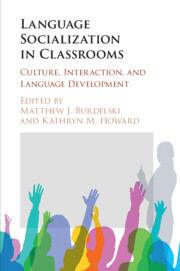Book contents
- Language Socialization in Classrooms
- Language Socialization in Classrooms
- Copyright page
- Dedication
- Contents
- Figures
- Tables
- Contributors
- Acknowledgments
- Transcription Conventions
- 1 Introduction
- Part I Socializing Values, Dispositions, and Stances
- 2 Interactional Contingencies and Contradictions in the Socialization of Tolerance in a Spanish Multicultural School
- 3 Shaping Sikh Youth Subjectivities in a US Gurdwara
- 4 Affective Stance and Socialization to Orthodox Christian Values in a Russian Heritage Language Classroom
- Part II Socializing Identities
- Part III Language Socialization and Ideology
- Part IV Conclusion
- Index
- References
3 - Shaping Sikh Youth Subjectivities in a US Gurdwara
Discursive Socialization of Religious Heritage in Sikh History Classes
from Part I - Socializing Values, Dispositions, and Stances
Published online by Cambridge University Press: 10 February 2020
- Language Socialization in Classrooms
- Language Socialization in Classrooms
- Copyright page
- Dedication
- Contents
- Figures
- Tables
- Contributors
- Acknowledgments
- Transcription Conventions
- 1 Introduction
- Part I Socializing Values, Dispositions, and Stances
- 2 Interactional Contingencies and Contradictions in the Socialization of Tolerance in a Spanish Multicultural School
- 3 Shaping Sikh Youth Subjectivities in a US Gurdwara
- 4 Affective Stance and Socialization to Orthodox Christian Values in a Russian Heritage Language Classroom
- Part II Socializing Identities
- Part III Language Socialization and Ideology
- Part IV Conclusion
- Index
- References
Summary
This chapter employs the language socialization approach to analyze the heteroglossic nature of linguistic practices and moral discourses in Sikh history classes at a US gurdwara (Sikh temple). Based on ethnographic audiovisual recordings, observations, and interviews carried out in a Sikh education program over a two-year period, analyses of classroom interactions during educational activities illuminate the semiotic repertoires that shape and reflect notions of ethno-religious identification in a minority community in transition and the multiple discourses tied to community survival. The analysis of classroom interactions reveals the collaborative and, at times, conflictual processes of coming to terms with forging a coherent model of Sikh community norms. The findings demonstrate how postcolonial concepts of modernity and transnational identity formation are reflected in youth experiences and language practices as they grapple with the contemporary sociopolitical landscape of the United States. The chapter provides a unique perspective on links between classroom discourse and diasporic community innovations.
- Type
- Chapter
- Information
- Language Socialization in ClassroomsCulture, Interaction, and Language Development, pp. 49 - 70Publisher: Cambridge University PressPrint publication year: 2020
References
- 2
- Cited by

